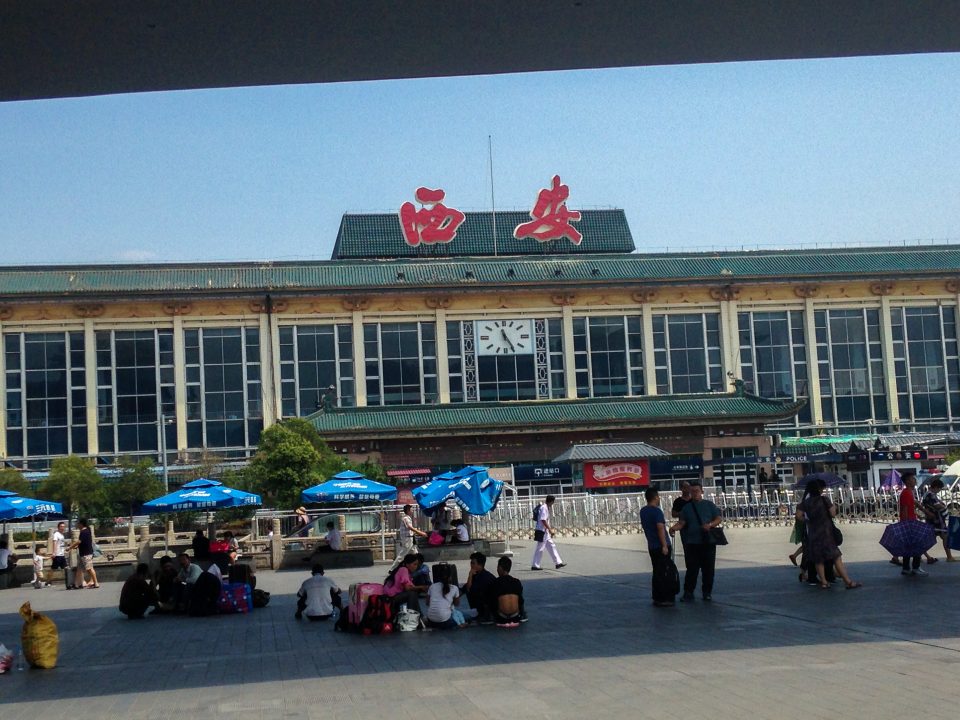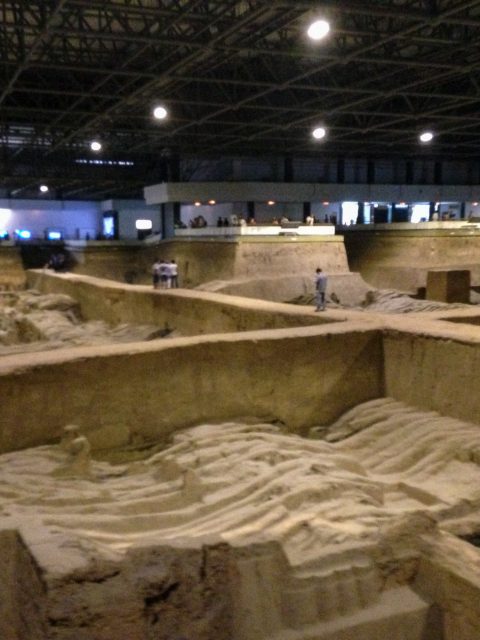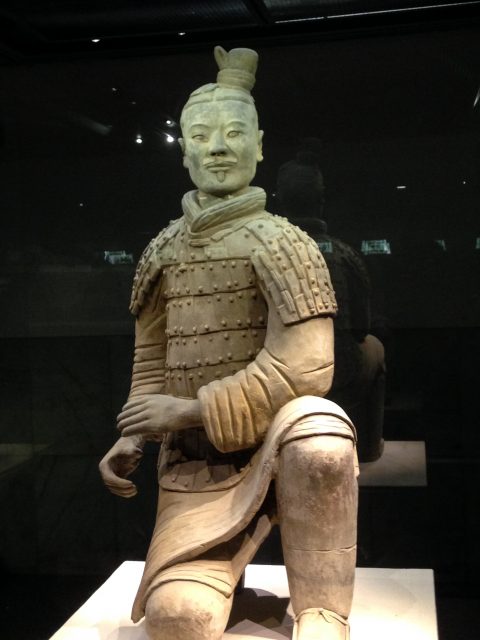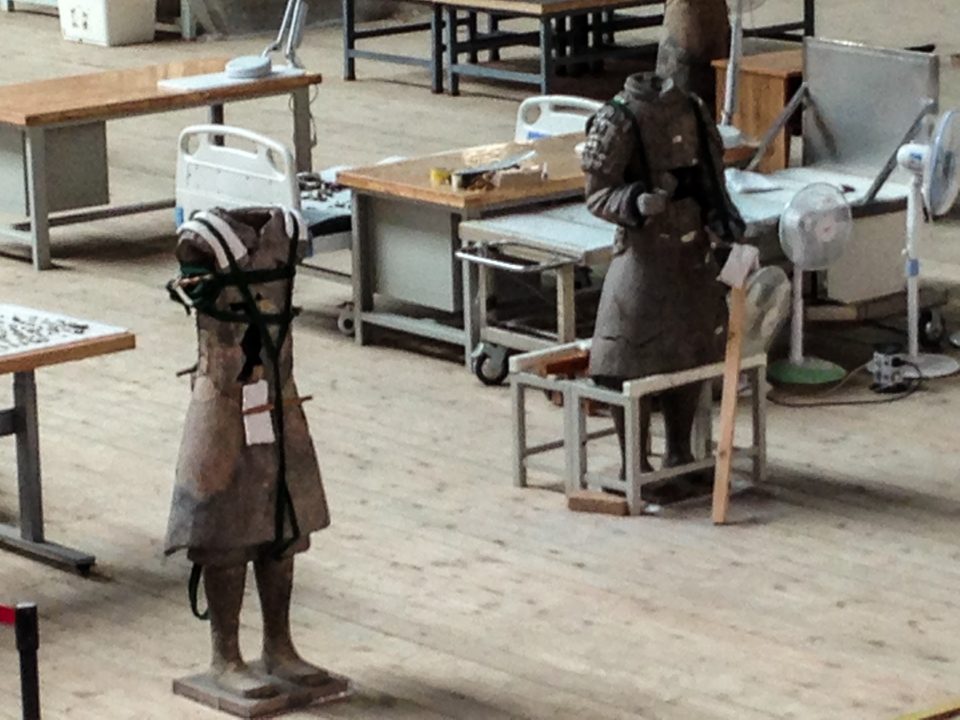The Rubble Terracotta Army of Emperor Qin Shi Huang
Published by CamDarling on
The Standing Terracotta Army is probably the grandest artistic project and act of self preservation in the history of civilized mankind. 8,000+ hand carved clay statues, each one a unique masterpiece armed with weapons to defend the first emperor of China in the afterlife. Nearby is the Emperor’s Mausoleum, an underground tomb the size of a small city with a miniature replica of his empire, riches beyond imagination and a river of flowing mercury. When you fully grasp the scale of this clay army, you’ll only begin to appreciate the history of Emperor Qin Shi Huang, a true legend.
Along with the Great Wall of China and the Forbidden City, the Terracotta Warriors outside of Xi’An draw tourists from around the World! We understand that people travel for different reasons, and spending all day looking at dirt and clay may seem a little boring without context. So we’ll dive into the history of the Qin Dynasty, the first to unify China around 230 BC. I’ll include some recommendations for books, movies and documentaries, and shed some light on the science behind the effort to reclaim this army of rubble from the ground. Lastly, we’ll include some instructions on getting to the museum site using cheap public transit, what to expect once there, and the hours of operation.
Terracotta Warrior Museum Hours & Fee
- Hours: 8:30 am to 6:00 pm March 16 to November 15, closes 30 minutes earlier in the off season
- Fee: 150 RMB ($22.50 USD) from March to November, 120 RMB ($18.00 USD) in the off season. Senior citizens over 65 and students (international incl.) with valid ID cards get 50% off the ticket price for admission.
- Services: Audio Guide available for 40 RMB ($6.00 USD), with a 100 RMB deposit ($15.00 USD)
- Notes: Shuttle Bus between Emperor Qin’s Mausoleum and the Terracotta Exhibits are free
First off, understand that this museum trip isn’t going to be your comfy, spacious, air conditioned Islamic Arts Museum or Atomic Bomb Museum. The Terracotta Warrior Museum grounds alone rival a theme park in size. Bring water, a small cloth, a snack and be prepared for crowds! In the heat of summer, temperatures can rise as high as 45 degrees in Xi’An. Consider bringing a parasol. Although the Exhibition Rooms are roofed, they are closer to airport hangars than buildings and visitors have to walk from one to another.
The museum saw over 2.6 million tourists in 2006, it’s 12 years later now, so I assume that total has doubled as domestic tourism in China has taken off! Getting a good photo means being very patient, in the thick of the crowd, and dealing with other tourists pushing their way to the front. Honestly, consider giving the taller person in your group the camera…
Be prepared for a long day, this isn’t a half day kind of excursion. I’m sure if rushed, the entire museum and second mausoleum site can be covered in 3 hours, but why? Having friends and family rush me while I am sightseeing is very irritating. Take some time and relax, rest between exhibitions, eat, breath and get the photos you really want. It’s a once in a lifetime travel destination. If someone gets tired or grumpy, I suggest they wait inside the main museum complex lobby.
Lastly, as a foreign tourist, Chinese tourist will ask for a photo. This is common and can make a great souvenir if you get a snapshot too. There are locals that will try and sell you some overpriced water, food or trinkets outside the main area, but most people just want a photo with you.
Reading & Movie List
- Secrets of the Dead: Season 11, Episode 3: China’s Terracotta Warriors (Youtube)
- National Geographic: China’s Ghost Army (Youtube)
- The First Emperor of China – 1990 (Youtube)
- The First Emperor – 2006 (Youtube)
- Secrets of the First Emperor (Amazon)
- The Immortal Emperor: Qin Shi Huang – 1996 (Youtube)
- Engineering an Empire: China (Youtube)
- Qin Yong / A Terra-Cotta Warrior -1989 (Youtube)
- The Incredible History of China’s Terracotta Warriors (Youtube)
- Empire Games Season 1 Episode 4 (Netflix)
For more books and documentaries on China, check out our China Books+ under Books & Things.
The First Emperor of China
In the west we learn of famous conquerors like Napoleon Bonaparte, Adolf Hitler, Julius Caesar, Alexander the Great, and the greatest of them all Genghis Khan. But we often overlook other great historical figures because of who and where they ruled. Anyone who has seen the Spartan movie 300 will recognize the name Xerxes, but not his predecessor Cyrus the Great who created the first Persian Empire…that would be conquered later by Alexander the Great. The point is that we are very selective about what history we popularize. Obviously history buffs will know all these famous figures, but for the average tourist, the conquest of Qin Shi Huang may be unknown!
All this to say, where Julius Caesar conquered Gaul (modern France) and transitioned the Romans from a republic into an empire, Emperor Qin Shi Huang did the same but earlier, grander and over a fear greater number of people. To this day, his remains are sealed away with the corpses of the very artisans that build his tomb.
Like Alexander the Great, Emperor Qin Shi Huang was born into power thanks to the political maneuvering of his father Yiren, his mother Lady Zhao and their trusted counselor Lu Buwei. Qin Shi Huang’s original name was Ying Zheng when he was born in 259 BC. He was the son of a concubine (Lu Buwei’s concubine) from the Zhao kingdom, one of the other 6 states in China as this time. His grandfather Anguo was the heir to the Qin Dynasty. Both his grandfather and father would inherit the throne and die, both within 4 or 5 years, but not before naming Ying Zheng as the prince and heir to the Qin kingdom. So at 13 years old, Qin Shi Huang became king of the Qin state, the most powerful state in China during this period officially referred to as the “Warring States Period”.
Conquering China One Kingdom at a Time
At 29 years old, Qin Shi Huang started what would become an 9 year conquest of the other 6 states in China. The first to fall was the small neighboring state of Han. Then a year later in 229 BC, the state of Zhao was crushed after already being weakened by a natural disaster. Two years later, the Yan state fell, followed by Wei state, and the second largest state geographically, Chu. By 222 BC, only Qi remained independent but knew their time was coming to an end. The King of Qi raised an army of 200,000 people, probably simple peasants, but were no match for the Qin’s forces. For the first time, China was unified under one ruler who named himself “Qin Shi Huang” (Qin First Emperor).
This unification is extremely relevant to today’s modern era. The 21st century is widely believed to be China’s emergence as a world super power. Although China as a country is currently much larger in territory than ancient China under Qin Shi Huang, it was built off of the Qin Dynasty’s foundation: Standardized Trade (Incl. units of measuring), Communication, Currency and Language. Before the Qin conquest, China was a mess of different tribes and states speaking different languages, using different writing styles and using different currency. Fast forward to today, people with shared language, culture, writing and tight economic trade are far more likely to identify as one than a mash of different people. Think of China versus the Eurozone.
With China firmly under his rule, Qin Shi Huang began mapping and connected all the different fortification from the previous states that made up North-Western China. He later expanded these walls to keep out the northern tribes (Early Mongolians) and this unified wall would later become the famed Great Wall of China 1000+ years later. The other major innovation under Qin Shi Huang was the construction of a canal system that linked two of China’s largest river systems: The Pearl River and the Yangtze River. This facilitated the movement of supplies for the Qin army, and trade over long distances. I’m sure Julius Caesar would appreciate this effort knowing the importance of managing supply lines.
Qin Shi Huang’s Fear of Death
Conquering every known civilization within proximity takes a great man, the Son of Heaven himself, a title Chinese Emperor’s would use for another 2000 years. But no man is immortal, yet. With the world at his fingertips, assassins tried to kill him 3 different times but failed. But consequently, the legend is that the Emperor became obsessed with the concept of immortality and sought an elixir to escape death.He employed alchemists and physicians at the high court in Xi’An and ordered the construction of his enormous Mausoleum/ Burial Tomb.
Records made 100 years later in China estimated that over 700,000 men built the tomb, but modern-day historians believe that estimate to be way too high. For entertainment’s sake, let’s image a work force of 700,000 people, probably gathered from every corner of the empire, working on this tomb that legends say holds replicas of palaces, 100 rivers of mercury and crossbow deathtrap for intruders. That after years of work, the artisans and builders most familiar with the tomb were trapped inside alive, to carry the secrets of the mausoleum to their graves.
Except for the fact he may have died from mercury poisoning from ingesting elixirs, arguably shortening his life. And he didn’t leave a will to clarify who would inherit the throne, which son would be the new emperor, leading to a brief conflict, weak leadership, and ultimately the collapse of the Qin Dynasty only 4 years after his death. Estate planning, still relevant 2000 years later.
Exhibition Pits 3, 2 & 1
The best advice I can give is to visit the smaller exhibition pits first! Pit 3, then 2 then 1. It’s less crowded and let’s you build up to seeing the big hangar at pit 1. After the big hangar, the other two seem so small. Each pit is unique and worth a visit.
As the story goes, farmers were building a well and digging not far from the Emperor’s Mausoleum site, already discovered by the 1970s. But the farmers found old pieces of clay buried in the ground, notably a head. They kept digging and discovered many more pieces. They alerted the local government and not long after the world learned of the terracotta army. In 1974, some rural farmers discovered the largest archaeological treasure of the 20th century.
The strangest mystery is why the army was unknown and lost for 2000 years. The soldiers were originally painted, and some in Pit 2 show signs of being burned. So historians suggest that when the Qin Dynasty fell in 206 BC, the new powers had the statues destroyed and the tomb of the First Emperor buried. But historians from 100 BC, only 100 years after the Qin Dynasty, wrote about the construction of the tomb on scrolls. So why not mention the army? You’d think a standing army of 10,000 artifacts, with stone armor and all armed with bronze weapons would be worthy of a comment or footnote, an honorable mention maybe?
Terracotta Museum Gallery
My friend Ben & I started at Pit 3 and ended at the Museum with all the artifacts on display. This way we got to experience the smaller pits and appreciate the statues from a little closer than the main hangar. The main museum is air-conditioned and houses some of the stunning artifacts found in the pits. Among the artifacts are various statues, weapons and two half sized imperial chariots, complete with a driver and four horses all made of bronze. The half size replica chariots are considered some of the greatest works of bronze craftsmanship in ancient history.
The Science of Assembling the Statues
The experience of visiting the Terracotta Army isn’t a simple moment of awe and then a quick bus ride back to the city of Xi’An. There is a lot more to appreciate when it comes to assembling these ancient statues. We are talking about thousands of hours of careful work to excavate each piece of clay from an area the size of a small town. Each piece is tagged, logged, and organized to recreate the original statue. It will take decades to unearth all the statues and artifacts.
I’ll be the first to admit I expected the unearthed statues to be in one piece, dug out and put on display. But of course that’s not reality, each one of the 8,000 solders, 520 horses and 130 chariots was turned to scattered rubble in the ground and buried for 2000+ years under up to 13 meters of soil. Since the pits were opened in 1979, scientists have worked to put together the pieces of the 400 lbs statues. They use modern science to recreate the missing pieces and rebuild the statues. Many of the statues have missing hands and feet, the parts most easily broken off. But others are missing heads which presents a real challenge since each statue’s face was unique. Meaning recreating a head would require designing faces from scratch.
Walking along Pit 1, you’ll see an assembly line of statues currently undergoing reconstruction and preservation. They even have harnesses for the horses. In Pit 2, archaeologist are working on unearthing and tagging the various pieces. The site is open all year, so the scientists work while tourists are visiting. It’s like being in a real life tomb raider movie, except without the death traps… well except for those in the actual tomb. So maybe I can be the next Lara Croft or Indiana Jones.
In the documentary “The First Emperor of China”, they claim there are over 180 different pits surrounding the Emperor’s Tomb, filled with statues of dancers, musicians, life-size sculptures of animals and more. The great tomb was not only the size of a small city, but also had buildings and a surrounding wall with gates only from the East and West.
Today, China sends individual statues all around the world for exhibitions that draw millions of tourists in cities like Manchester, Liverpool, Philadelphia, Cincinnati, Ottawa, Montreal etc…
Getting to the Terracotta Army
Ben and I didn’t book a tour to visit the Terracotta Warriors, we simply used the local public transit and made our way to the site on our own and it was super easy!
Xi’An has a great subway line that runs directly through the middle of the inner city (part inside the wall). It’s the red line or line No. 2. Or you can simply walk to the main railway station at the North-East corner of the inner city wall. The confusing part is that there is a north Railway Station, A South Railway Station, and the Xi’An Railway Station. You’ll want the regular Xi’An Railway Station very close to the wall in the downtown core. The bus station is to the right facing the building, just walk on and a staff will come around and collect the cash 9 RMB ($1.20 USD).

From the Downtown Xi’An Railway
- To the right of the train station are the local buses
- Take Bus 306 for 1 hour directly to the site (Line 5, #306)
- 7 to 9 RMB ($1.00 to $1.30 USD)
- In China, walk on the bus and grab a seat. Staff come over and you buy tickets directly from them.
- Buses leave when full, roughly every 15-30 minutes.
From the Xi’an Airport
- Shuttle Bus from the Airport that departs from the East Square towards the Xi’an Railway Station
- Shuttle Bus takes roughly 20 minutes and costs 25 RMB ($3.50 USD)
- Find bus 306 – Follow the instructions above
From the North Railway Station
- With an express ticket in hand having just arrived at the North Railway Station, head down to level 1F and purchase a ticket for the Terracotta Army Site from the Tourist Service Center
- Grab the Free Shuttle Bus, ask a staff where to find the bus outside the station. It’s in the west square, but that can be confusing from inside such a big station.
More Info on China
Traveling in China can be a challenge due to the language barrier and internet censorship. Check out the Best VPNs for China so you can use Google Maps, Instagram and Facebook, plus any of these Apps we recommend for China. And consider pick up a SIM Card for cheap to share all those awesome moments live with friends.
We know researching for a trip can be tedious. So we put together a List of Books, Movies and Podcasts to get you in the mood for travel to China. Check it out under Books & Things.
If you haven’t read our article on The Great Wall or The Forbidden City, we dived into different Dynasties and important characters in Chinese history. We also explored the dark history of the Opium Wars at The Summer Palace and the Chinese Hero Qi Jiguang who guarded The Great Wall.





























